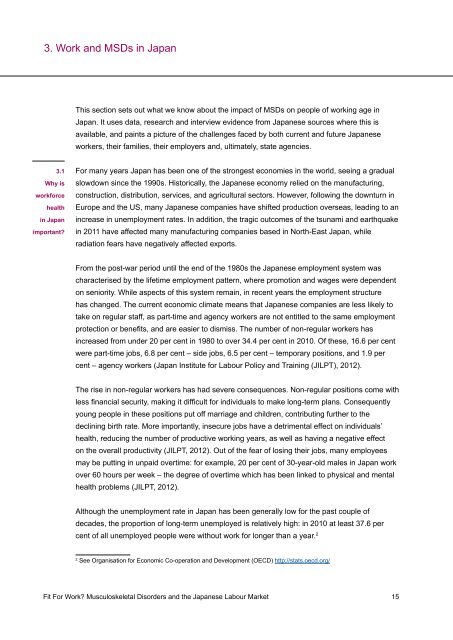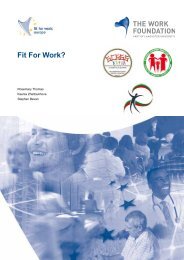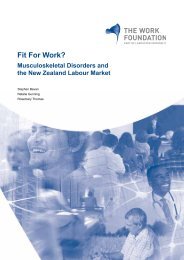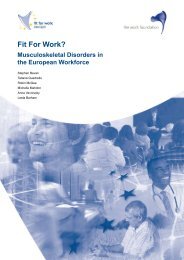English version - Fit for Work Europe
English version - Fit for Work Europe
English version - Fit for Work Europe
You also want an ePaper? Increase the reach of your titles
YUMPU automatically turns print PDFs into web optimized ePapers that Google loves.
3. <strong>Work</strong> and MSDs in Japan<br />
3.1<br />
Why is<br />
work<strong>for</strong>ce<br />
health<br />
in Japan<br />
important?<br />
This section sets out what we know about the impact of MSDs on people of working age in<br />
Japan. It uses data, research and interview evidence from Japanese sources where this is<br />
available, and paints a picture of the challenges faced by both current and future Japanese<br />
workers, their families, their employers and, ultimately, state agencies.<br />
For many years Japan has been one of the strongest economies in the world, seeing a gradual<br />
slowdown since the 1990s. Historically, the Japanese economy relied on the manufacturing,<br />
construction, distribution, services, and agricultural sectors. However, following the downturn in<br />
<strong>Europe</strong> and the US, many Japanese companies have shifted production overseas, leading to an<br />
increase in unemployment rates. In addition, the tragic outcomes of the tsunami and earthquake<br />
in 2011 have affected many manufacturing companies based in North-East Japan, while<br />
radiation fears have negatively affected exports.<br />
From the post-war period until the end of the 1980s the Japanese employment system was<br />
characterised by the lifetime employment pattern, where promotion and wages were dependent<br />
on seniority. While aspects of this system remain, in recent years the employment structure<br />
has changed. The current economic climate means that Japanese companies are less likely to<br />
take on regular staff, as part-time and agency workers are not entitled to the same employment<br />
protection or benefits, and are easier to dismiss. The number of non-regular workers has<br />
increased from under 20 per cent in 1980 to over 34.4 per cent in 2010. Of these, 16.6 per cent<br />
were part-time jobs, 6.8 per cent – side jobs, 6.5 per cent – temporary positions, and 1.9 per<br />
cent – agency workers (Japan Institute <strong>for</strong> Labour Policy and Training (JILPT), 2012).<br />
The rise in non-regular workers has had severe consequences. Non-regular positions come with<br />
less financial security, making it difficult <strong>for</strong> individuals to make long-term plans. Consequently<br />
young people in these positions put off marriage and children, contributing further to the<br />
declining birth rate. More importantly, insecure jobs have a detrimental effect on individuals’<br />
health, reducing the number of productive working years, as well as having a negative effect<br />
on the overall productivity (JILPT, 2012). Out of the fear of losing their jobs, many employees<br />
may be putting in unpaid overtime: <strong>for</strong> example, 20 per cent of 30-year-old males in Japan work<br />
over 60 hours per week – the degree of overtime which has been linked to physical and mental<br />
health problems (JILPT, 2012).<br />
Although the unemployment rate in Japan has been generally low <strong>for</strong> the past couple of<br />
decades, the proportion of long-term unemployed is relatively high: in 2010 at least 37.6 per<br />
cent of all unemployed people were without work <strong>for</strong> longer than a year. 2<br />
2 See Organisation <strong>for</strong> Economic Co-operation and Development (OECD) http://stats.oecd.org/<br />
<strong>Fit</strong> For <strong>Work</strong>? Musculoskeletal Disorders and the Japanese Labour Market 15







